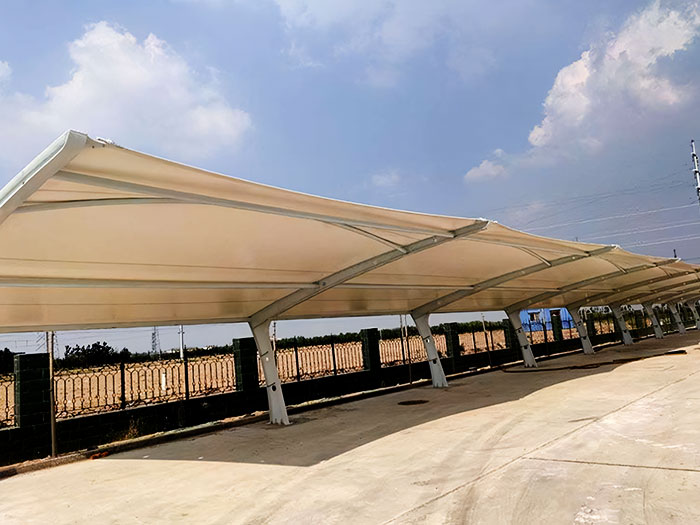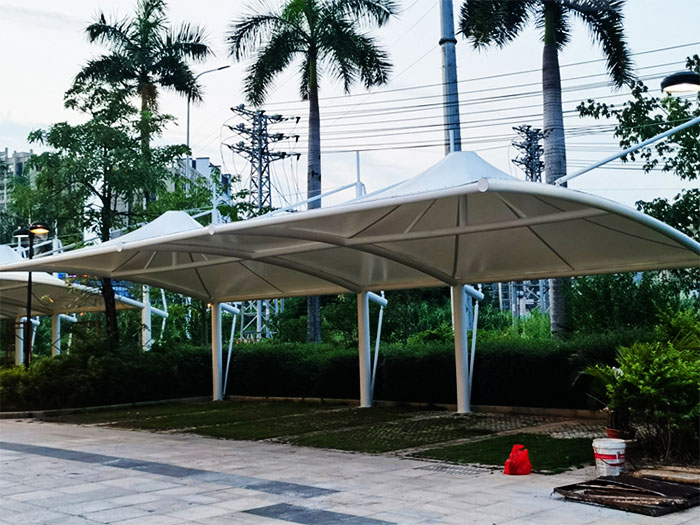What is the difference betwee fabric tensile structure carport and traditional carport?
Compared with traditional carports, fabric tensile structure carports have demonstrated their unique advantages in multiple aspects. Below, I will elaborate in detail on the differences between fabric tension structure carports and traditional carports from the aspects of structure, design, function, durability, cost, and environmental friendliness.
Firstly, structurally speaking, the fabric tensile structure of the car shed adopts advanced tension membrane technology, which tightens the membrane material through prestressing to form a stable spatial structure. This structural form does not require excessive internal support and can create a larger accessible visual space, effectively increasing the space usage area. Traditional car sheds, on the other hand, often use steel or concrete structures, requiring more columns and beams for support, resulting in relatively low space utilization.
Secondly, in terms of design, the fabric tension membrane structure carport has higher flexibility and creativity. It relies on shape and color, combined with natural conditions, to fully unleash the architect’s imagination and create curves and various shapes that traditional carports are difficult to achieve. This makes the tensile membrane carport not only practical, but also highly artistic and aesthetically pleasing. Traditional car sheds, on the other hand, are relatively conservative in design, with a single shape and color scheme.

In terms of functionality, the fabric tensile structure of the carport also performs well. It has good transparency and shading performance, and can automatically adjust the light according to the angle of sunlight exposure, providing a comfortable parking environment for vehicles. At the same time, the tension film material has flame retardancy and high temperature resistance, which can meet the fire protection requirements. In addition, its lightweight characteristics and good seismic performance also ensure the safety performance of the overall structure of the carport. In contrast, traditional car sheds perform relatively average in terms of shading, light transmission, and fire prevention.
In terms of durability, fabric tension structure carports also have advantages. The membrane materials used have been specially treated, and have excellent anti-aging and anti ultraviolet properties, which can maintain stable performance in harsh natural environment for a long time. However, the steel or concrete structures of traditional car sheds are susceptible to corrosion, aging, and other factors during long-term use, leading to a decrease in performance.
In addition, from a cost perspective, although the initial investment of fabric tension membrane structure carports may be slightly higher than traditional carports, due to its advantages such as long service life and low maintenance costs, in the long run, its comprehensive cost is not higher than traditional carports.
Finally, from the perspective of environmental friendliness, the materials used in fabric tensile structure carports are mostly recyclable, which has a relatively small impact on the environment. At the same time, its good lighting performance also helps to reduce energy consumption, which is in line with the current development trend of green buildings. However, traditional car sheds are relatively traditional in terms of material usage and energy consumption.

In summary, compared with traditional carports, the fabric tension structure carports have demonstrated their unique advantages in terms of structure, design, function, durability, cost, and environmental protection. With the increasing demands of people for the aesthetics, practicality, and environmental friendliness of buildings, fabric tensile structure carports will undoubtedly become the mainstream choice for future carport construction.